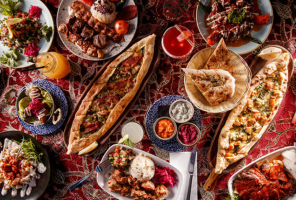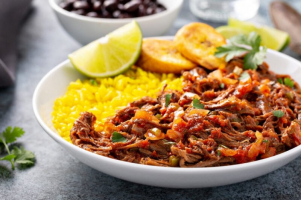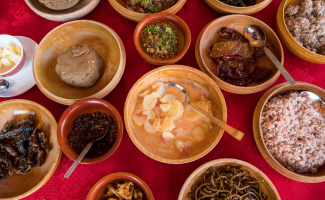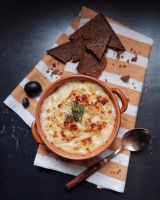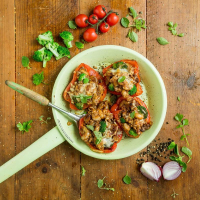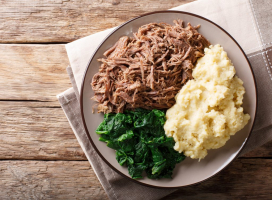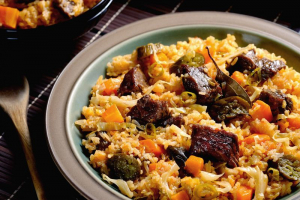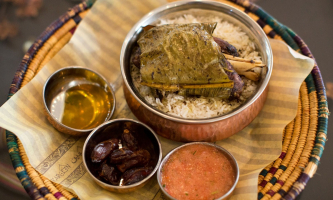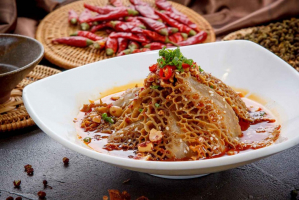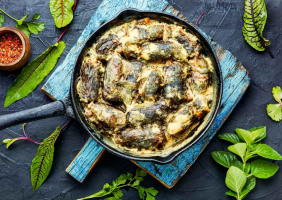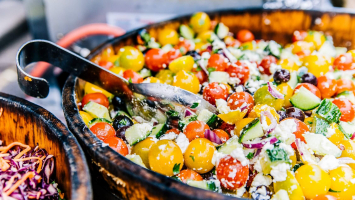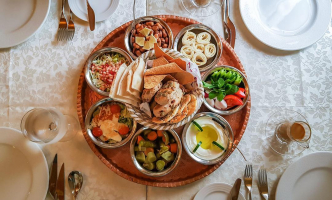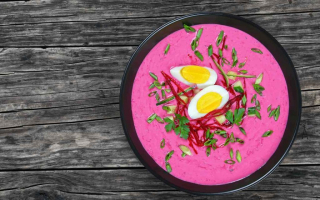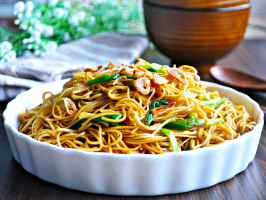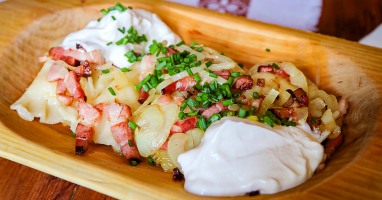Top 10 Best Croatian Foods - With Recipes
Croatia is a country with incredible diversity, with approximately 2000 kilometers of coastline, over 1000 islands, lowland plains, alpine peaks, deep caves, ... read more...and stunning waterfalls. If you are planning a trip to Croatia and appreciate sampling different foods, you are in for a treat. This post features the best Croatian meals you must try, ranging from wonderful seafood to sophisticated charcuterie, sweet Croatian desserts to robust meat stews, fancy restaurant cuisine to delightful Croatian street food. Let’s begin with the first name!
-
Although it may appear to be a creation from outer space, black risotto is a very popular Croatian dish - and it is incredibly wonderful. This dish is known as "crni rizot" in Croatian, and it is a common sight on restaurant menus along the country's wide coastline. Black risotto can also be found inland.
Squid ink, which is added at the last minute to stain the black risotto, is what gives it such a dark color. It is usually cooked using cuttlefish or squid as the main ingredient, and despite its richness, the flavor is not overbearing. With garlic, olive oil, red wine, and fish, black risotto is a simple but effective dish.
Ingredients:
- 1 kg (2 lb) squid, cuttlefish or calamari
- 2 to 3 large chopped onions
- 1/3 cup (80 ml) olive oil
- 3 minced garlic cloves
- 1/4 cup white wine
- 400 mL (0.9 lb; about 2 cups) rice risotto (like Arborio)
- 4 g squid ink (about 1 tsp)
- Butter
- 2 cups fish stock or veggie stock or hot water
- Salt and black pepper
Instructions:
- Clean the squid or calamari before making the black risotto (reserve the ink sac). Cut this squid or calamari into stripes.
- In a skillet, cook the onion until it is translucent. Cook for 15 minutes after adding the squid or calamari. Cook until the squid or calamari are soft, adding garlic, parsley, salt (careful with the salt because the stock is salty), wine, pepper, and enough water to cover the calamari (squid will take a longer time to cook than calamari).
- Continue to simmer on low to medium heat with the rice and the ink from the ink sac. Ladle in the hot stock, stirring constantly until it is absorbed. Season to taste.
- When the rice is cooked al dente, remove the black risotto from the heat. Add a knob of butter and mix well. Cover and set aside for 10 minutes.
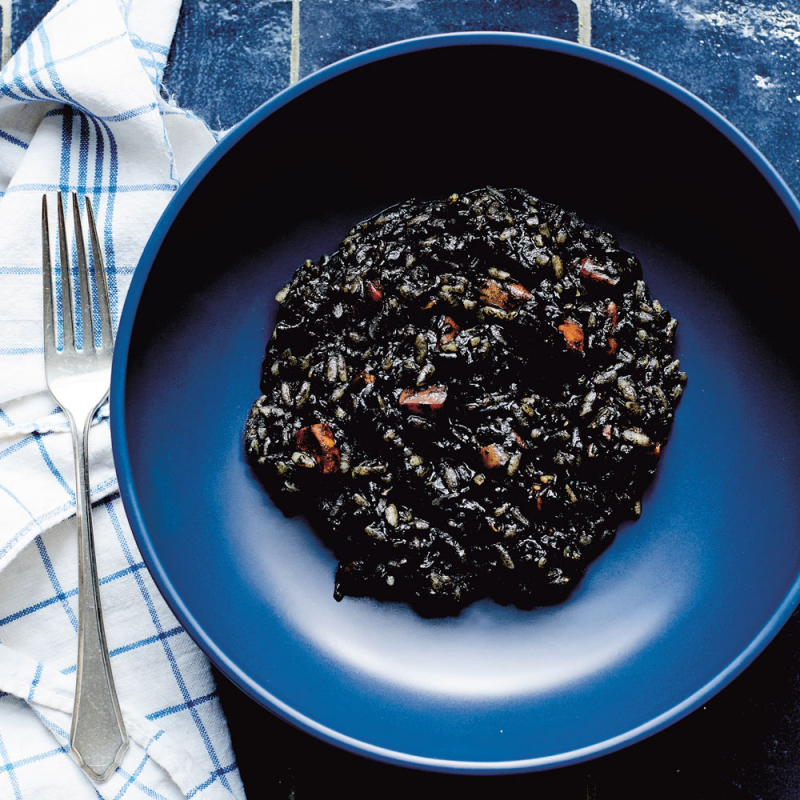
Black Risotto. Photo: foodandwine.com 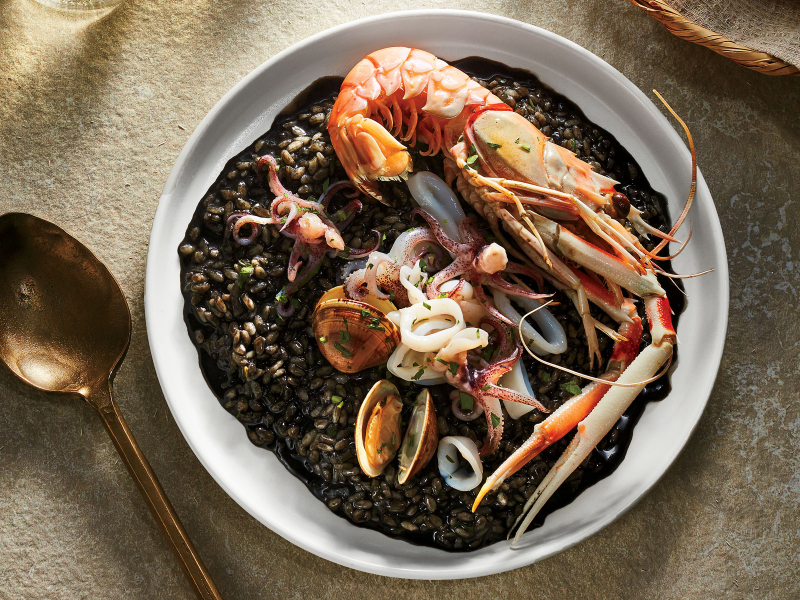
Black Risotto. Photo: foodandwine.com -
Brudet, also known as "Brodetto" or "Brodet" is a classic Croatian dish popular along the Croatian coast. It is a fish stew with a variety of fish and crustaceans cooked together in a wonderful oniony tomato sauce. It is frequently served with polenta, which absorbs all of the liquids.
Because of the variety of seafood used, Brudet is extremely filling — fisherman traditionally uses whatever catch they have that day, so components might range from tuna and grouper to clams and langoustines. This dish is available all year, with changing ingredients depending on the season.
Ingredients:
- 2 pounds of seafood and fish (baby scallops, white firm fish, shrimp, mussels, clams, calamari)
- 3 tablespoons of olive oil
- A can (28 ounces) of diced tomatoes
- 3 - 4 minced garlic cloves
- 1 tablespoon fresh basil
- 1/2 cup white wine (dry)
- 1 tablespoon fresh parsley
- Salt and black pepper
- Saffron threads, pinch (15-20 treads)
Instructions:
- Fish and seafood should be cleaned and washed. A one-inch slice of white fish should be cut.
- Garlic, basil, parsley, and saffron are cooked in olive oil. Cook for 30 seconds (saffron is not traditional)
- When the garlic begins to smell, add the wine and simmer for another 2-3 minutes.
- Season with salt and pepper and add the diced tomatoes.
- Cook for 10 minutes.
- If you are making anything for later or the next day, you can stop now.
- Cover the fish and shrimp in a boiling tomato stew.
- Allow 3-4 minutes to cook without stirring; instead, shake the pot.
- Add the calamari, baby scallops, clams, and mussels.
- Allow everything to cook for another 2-3 minutes when the water returns to a boil.
- Remove from the heat and top with parsley.
- It is usually served with polenta or other wonderful rustic bread.
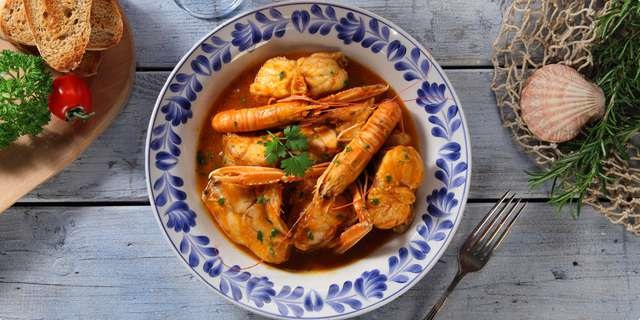
Brudet. Photo: rosacooking.com 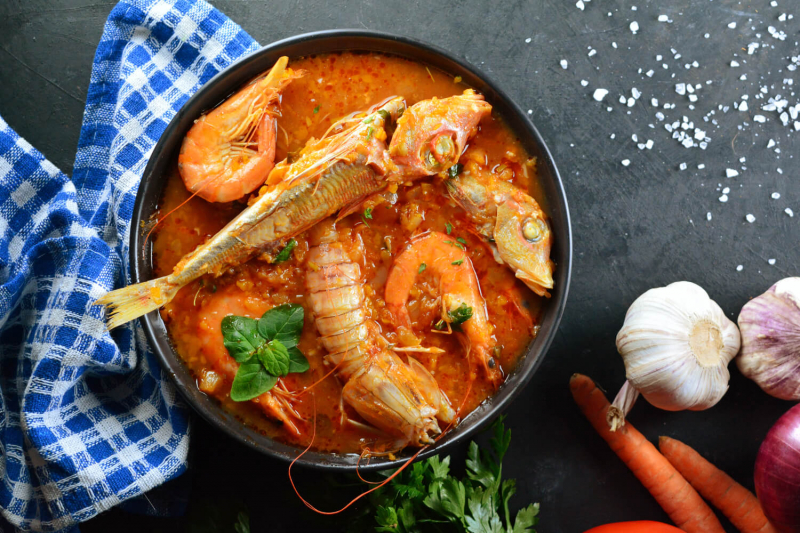
Brudet. Photo: camping-simuni.hr -
For those with a sweet tooth, here is something to try! Fritule is a dessert-oriented Croatian national cuisine. It is made up of miniature fried pastry balls filled with rum and raisins, similar to doughnuts.
Fritule is a traditional Croatian Christmas dish that is powdered with icing sugar and served with orange peel and lemon zest, or even chocolate sauce. Fritule can be found in restaurants and street booths all around Croatia, but it originated in Dalmatia. Nothing beats buying some of these delectable Croatian treats from a market booth and strolling around one of the country's stunning bays.
Ingredients:
- An egg
- 1 cup of yogurt
- 1 to 2 cups of flour
- 1 tsp vanilla
- 2 tsp of baking powder
- 1 tbsp rum or brandy
- 2 tbsp sugar
- Raisins (optional)
Instructions:
- Combine all ingredients in a mixing bowl.
- Drop rounded teaspoonfuls of batter into hot oil and cook 2 or 3 at a time, rotating with a slotted spoon as needed, until brown, about 4-5 minutes.
- Use paper towels to absorb excess liquid and dust with confectioners' sugar.
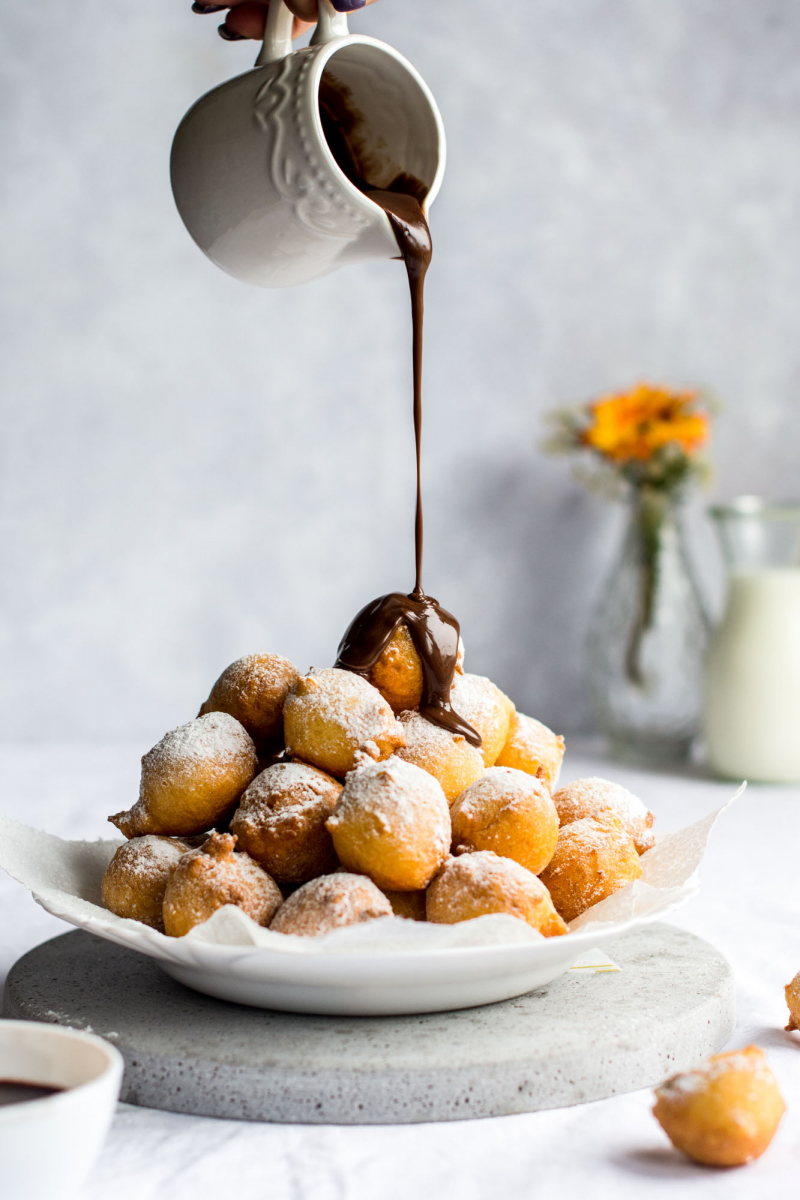
Fritule. Photo: biteitquick.com 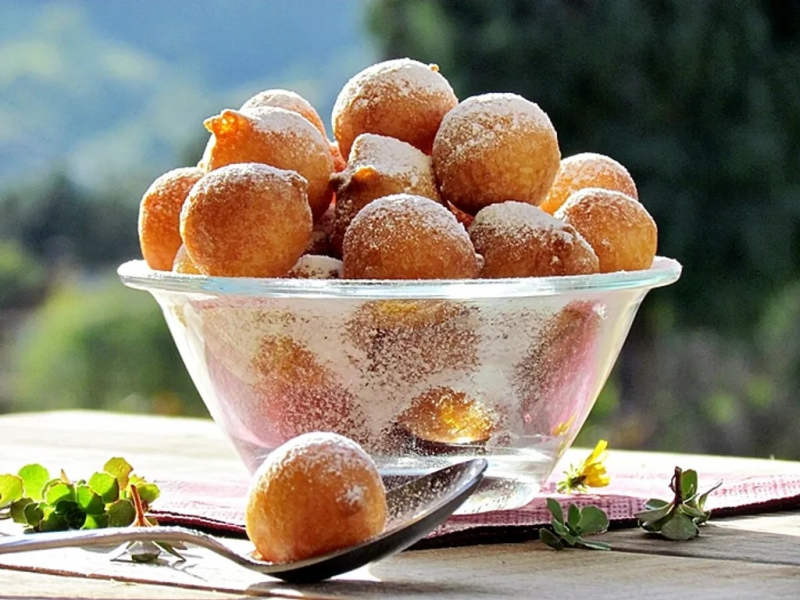
Fritule. Photo: coolinarika.com -
Peka is a classic Croatian dish that can be found on most menus. However, if you know you want to eat it, you should order it ahead of time because it takes a long time to prepare.
Despite its reputation as the best Croatian cuisine, it is a relatively simple dish. Peka is produced by cooking meat, vegetables, or shellfish in a terracotta dome-shaped lid with potatoes, spices, salt, and oil. This is then coated in coals in a fireplace and left to slowly bake for a number of hours. It can be cooked with any meat or fish (lamb, chicken, and veal are popular). Octopus is an amazing addition to this recipe since it becomes quite tender when cooked under the lid. To mop up the delectable sauce, it is usually served with some Croatian bread.
Ingredients:
- 2 kg of shoulder/flank veal or shoulder/ribs/leg lamb (4.4 lbs)
- 1 tbsp of salt
- 100 ml vegetable oil/2 tbsp lard
- 1 kg of potatoes (2.2 lbs, quartered)
- 2 carrots (roughly chopped)
- 1 quartered big onion
- 1 quartered bell pepper
- 3 garlic cloves (halved)
- 1 tsp of pepper
- 2-3 thyme twigs
- 1/2 cup water (100 ml)
- 100 ml dry white wine (1/2 cup)
Instructions:
- Start the fire an hour before you build the peka. Because they produce the longest-lasting embers, choose beech or hornbeam wood. Make sure the firebox (which in the case of peka is usually composed of chamotte/fireclay) is very hot. Clear some space in the middle of the fire once it has turned to embers.
- Season the meat with salt. Place the meat in the center of the pan and grease it with lard/oil.
- Prepare the vegetables and place them in a circle around the meat. Season with thyme and pepper (or any other Mediterranean herb, such as rosemary or sage). Pour in the water as well.
- Cover the pan with the peka lid and place it on the hot firebox. Roast for 30 minutes with one-third of the embers on the lid.
- Roast for another 30 minutes with the residual embers on top and around the peka lid.
- Turn the meat around after opening lid and pouring the wine in. If you see evidence of charring on the vegetables, do the same.
- Replace the cover and the embers. Roast for a further hour.
- Check if the meat is tender by opening the cover. The meat must be fall-off-the-bone tender, and the liquid must be reduced to a minimum. The meat, as well as the vegetables, should be golden in color. It's possible that you'll need another 30 minutes to accomplish this.
- Peka takes at least 2 to 2.5 hours to cook, and you may need to open the lid twice to get the ideal outcome.
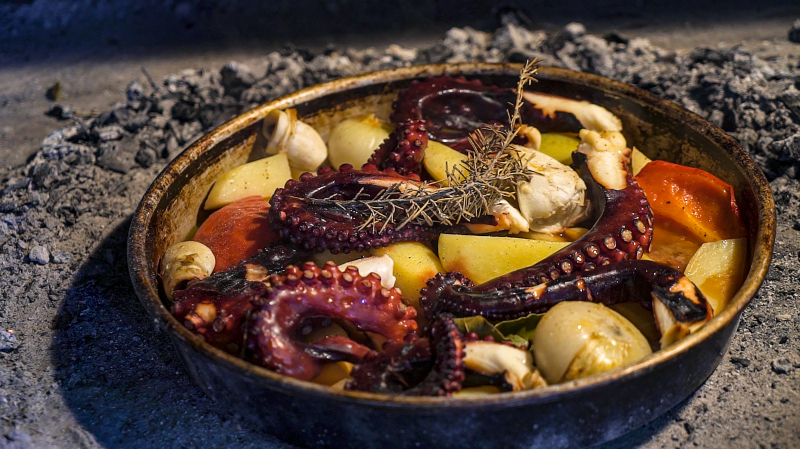
Peka. Photo: sail-croatia.com 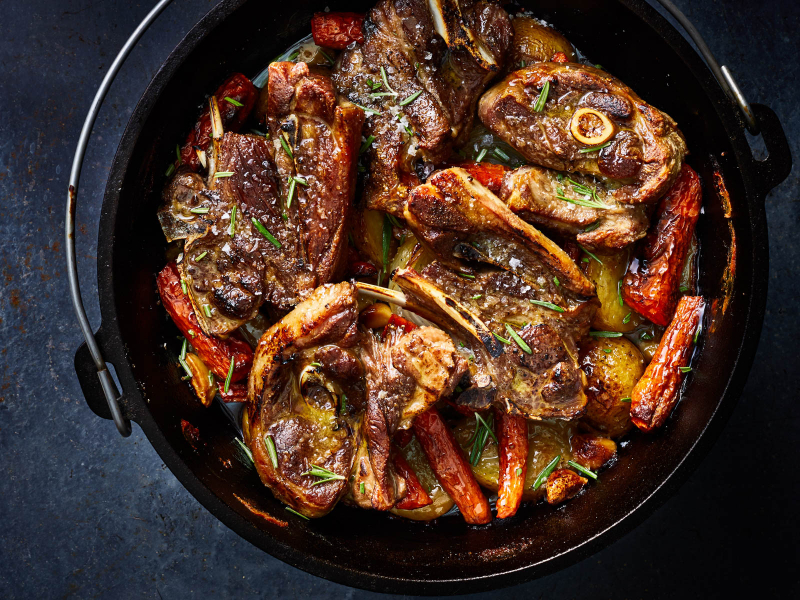
Peka. Photo: foodandwine.com -
Pasticada has to be on the top of the list of Croatian dishes you must try if you get the opportunity. It is a Dalmatian marinated beef stew that is commonly served with gnocchi and includes prunes or figs, bacon, nutmeg, and red wine.
The meat is typically marinated for at least a day (and sometimes many days) before serving. It's one of the Croatian dishes that is frequently served during special occasions or festivities - and it is easy to see why, given the amount of work, effort, and ingredients that go into it.
Ingredients:
- 3 to 4 pound round of beef
- 5 sliced garlic cloves
- 4 ounces bacon, cut into 12-inch/1-centimeter chunks
- 4 cup wine vinegar
- 1/2 cup olive oil
- A cup of vegetable broth (or beef broth)
- 3 quartered onions
- 2 peeled and sliced carrots
- 1 peeled and quartered celery root
- 1 peeled and quartered parsley root
- 1 tablespoon of flour
- 4 whole garlic cloves
- 2 tablespoons of tomato paste
- 1/2 cup prosek
- 1 bay leaf
- 1 tablespoon of sugar
- 1/2 cup dry red wine
- 4 prunes
- 1 pound gnocchi
- 1/2 bunch of chopped parsley
- Salt and pepper
- Parmesan cheese (optional)
Instructions:
- With a sharp-pointed knife, pierce the meat and insert pieces of garlic, bacon, and cloves.
- On a big plate, place the beef. Refrigerate it overnight after covering it with vinegar.
- The next day, remove the meat from the vinegar. Remove the bacon and garlic cloves and set them aside.
- Place the meat in a Dutch oven or a large saucepan. After flouring the meat, add olive oil.
- Cook on a medium-high heat setting. After around 8 to 10 minutes, when the meat has developed color on both sides, remove it.
- In the same oil, fry the onion, garlic, and bacon for a few minutes.
- Return the meat to the pot, add the stock, and simmer for 6–8 minutes.
- The carrots, celery root, and parsley root are added after the tomato paste has been diluted with sweet wine.
- Add the red wine and sugar, and simmer for 3 hours on low heat, covered, until the meat is cooked.
- Add the bay leaf and prunes halfway through the cooking process.
- Remove the meat to a platter and chop it into thick slices when it is tender.
- Using a hand blender, puree the remaining vegetables and sauce in the pot.
- Serve with gnocchi (made from potatoes).
- Serve with parsley or grated parmesan cheese as a garnish (optional).
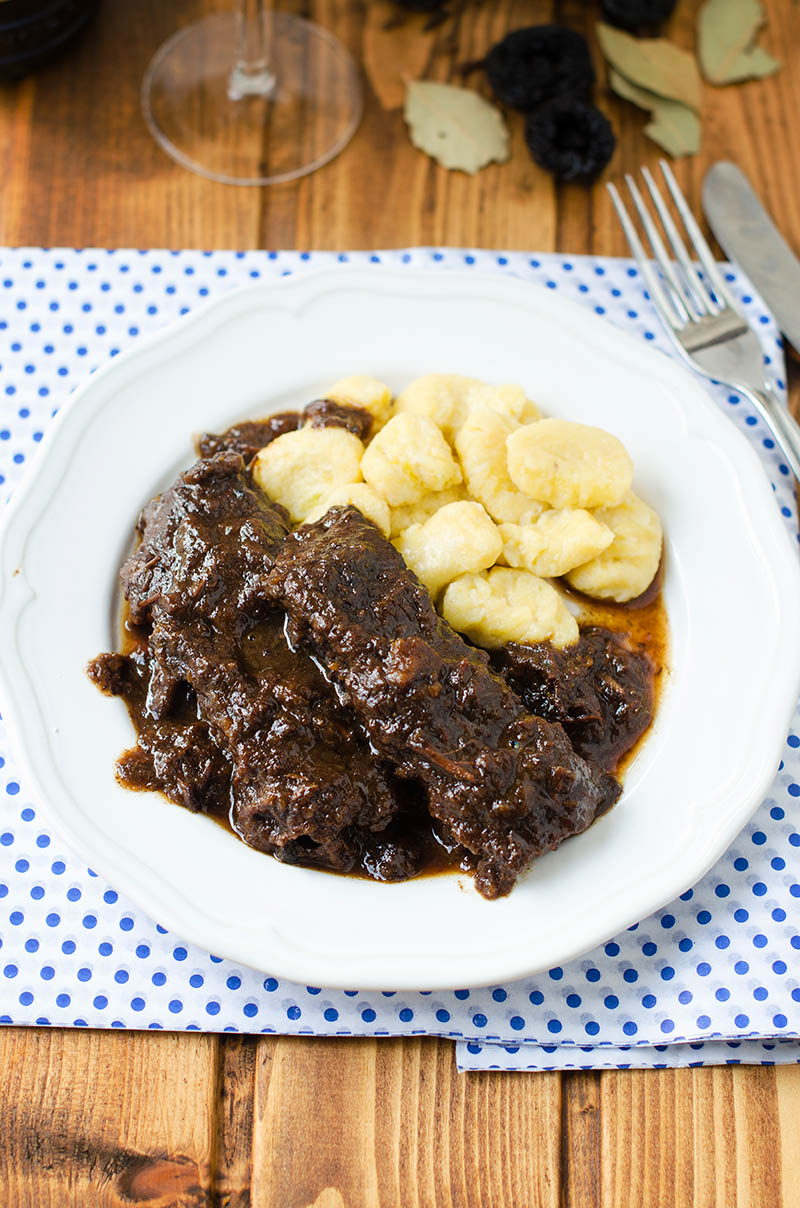
Pasticada. Photo: biteitquick.com 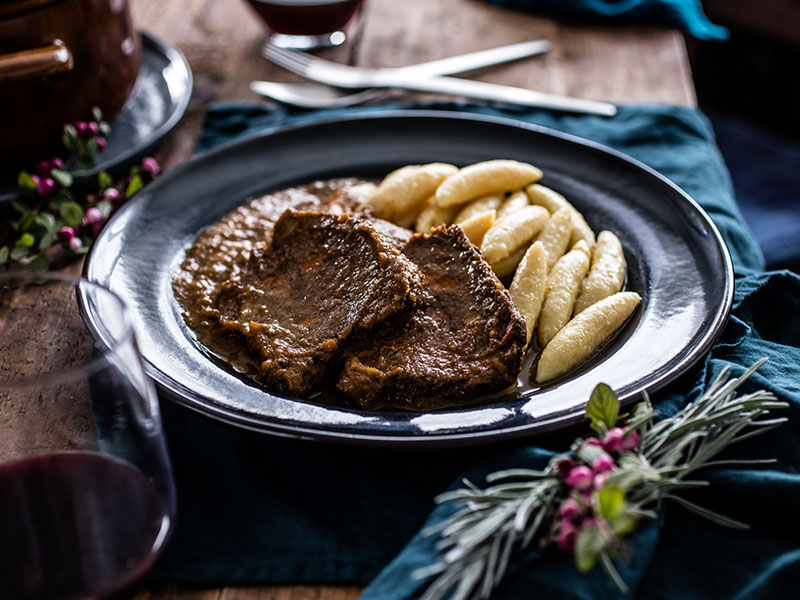
Pasticada. Photo: croatia.hr -
If you plan on spending any time by the water in Croatia, you must sample some of the local seafood and fish. Buzara is a terrific way to get started. It basically translates to "stew" or "broth", and it is a quick and easy technique to prepare shellfish.
Buzara can be made with a variety of ingredients, including mussels, langoustine, shrimp, clams, or scampi, and is comparable to moules marinieres. White wine, parsley, and garlic form the foundation of this classic dish. As a finishing touch, breadcrumbs are frequently sprinkled on top.
Ingredients:
- 4 pounds of mussels
- 3/4 cup of olive oil
- 8 garlic cloves
- 1/4 cup of chopped parsley
- 1 and 1/4 cup white wine
- Salt
- Black pepper
- 1/2 to 3/4 cup of fresh breadcrumbs
- 1 baguette (optional for serving)
Instructions:
- Gather the necessary ingredients.
- Scrub and debeard the mussels. The hairy item dangling from one side of the shell is the "beard". With a side-to-side motion, pull it off.
- Add debearded mussels, 3/4 cup olive oil, 1/4 cup chopped fresh parsley, and 8 garlic cloves (more or less) to a large, hot skillet. Allow it to simmer, undisturbed, until the mussels are just starting to open. Stir in 1 and 1/4 cup dry white wine, coarse sea salt, and black pepper to taste, then reduce heat to low.
- Let all of the shells open, stirring once in a while. If any shells do not open by the conclusion of the cooking time, discard them. Return the heat to high to speed up the cooking process while avoiding toughening the mussel meat.
- Mix in 1/2 to 3/4 cup of fresh breadcrumbs to the broth, but make sure there is still enough moisture. Serve it with crusty bread.
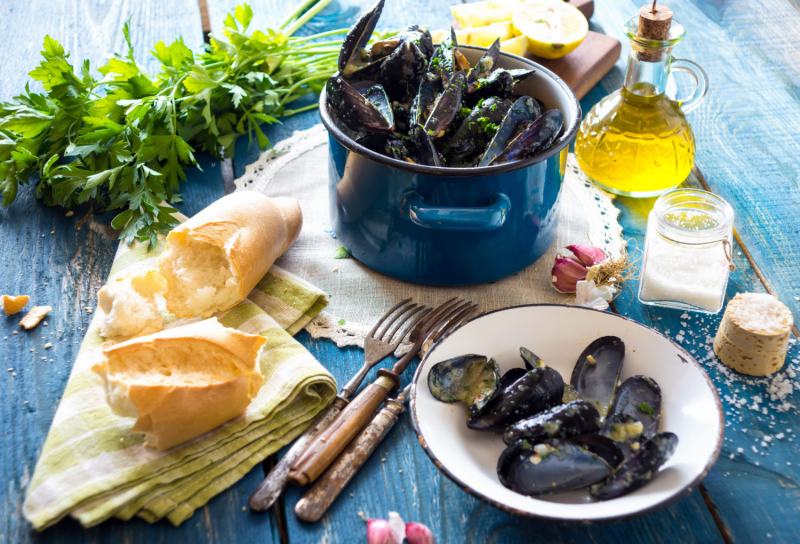
Buzara. Photo: camping-simuni.hr 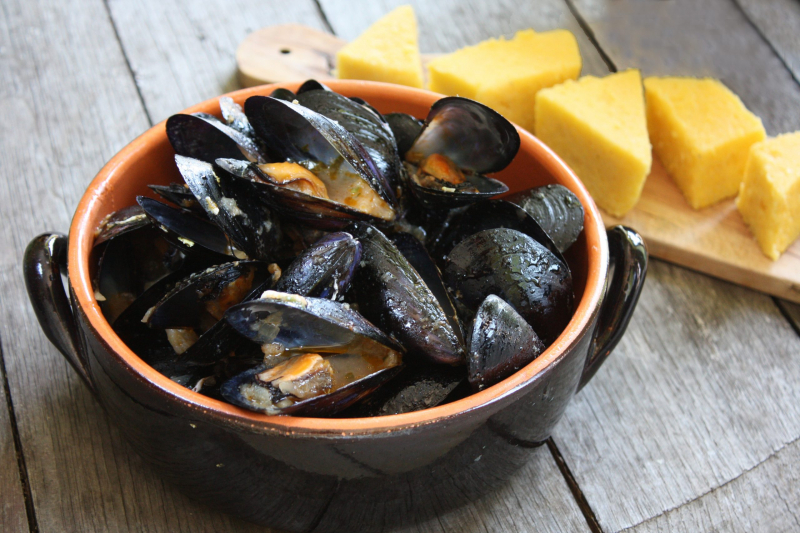
Buzara. Photo: academy.thechefscut.com -
Fuzi is a well-known Croatian pasta that is simple to cook and is a household staple in Croatia. It is prepared by rolling little squares of pasta into a quill shape around the end of a pencil or wooden spoon. Fuzi is typically served as a substantial stew of wild game or other meats, or in a truffle cream sauce. It is an example of typical Croatian cuisine that can be found all across the country.
Ingredients:
- 2 lbs. of stew meat (veal or beef)
- A yellow onion
- 2 tbsp tomato paste
- 2 tbsp of flour
- 3 to 4 cups of water
- 2-3 tablespoons Vegeta
- Salt and pepper
Instructions:
- Cook the onion in olive oil until translucent, then add the beef and cook for 5 to 6 minutes with the onion.
- Season with salt and pepper and add tomato paste, flour, water, and Vegeta seasoning.
- Bring to a boil, then reduce to low heat, cover (leaving some space for steam to escape), and cook for at least an hour.
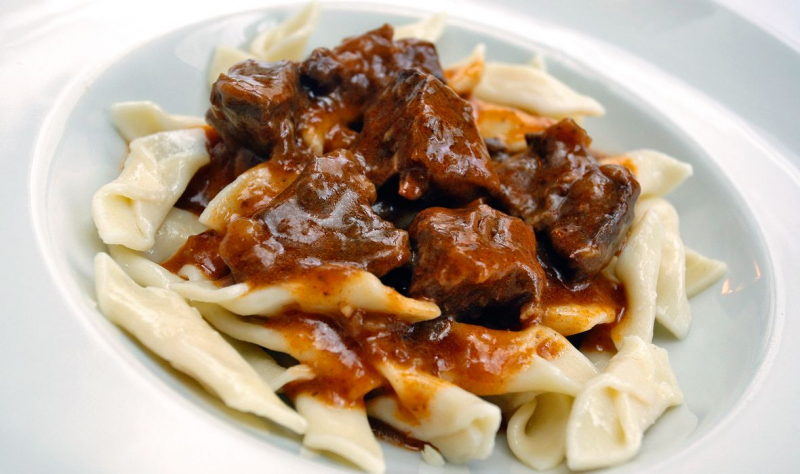
Fuzi. Photo: croatia-times.com 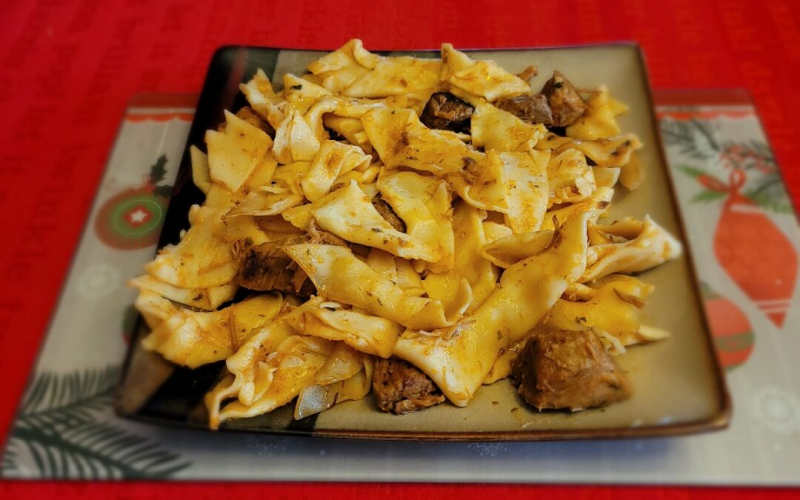
Fuzi. Photo: coffeecraftschaos.com -
Vegetarians may find it difficult to eat out in Croatia because so much of the traditional cuisine contains meat – and even the vegetarian versions often include bacon or pancetta. On the other hand, manestra is a popular vegetable soup that can be found in restaurants all around Croatia. It is still a good idea to double-check that it is meat-free, as pancetta is sometimes ground into the paste that forms the dish's foundation.
Manestra differs depending on where you go; sometimes it is a bean soup, and other times it is a soup with various veggies as its foundation. This is the kind of dish that locals eat for lunch, and it is often prepared hours ahead of time and simmered on low heat.
Ingredients:
- 300 g potatoes
- 300 g carrots
- 300 g celery
- 300 g zucchini
- A corn
- An onion
- Olive oil
- 250 ml white wine
- 100 g peas
- 1 cube vegetable stock
- 1 teaspoon of origano
- 8 fresh basil leaves
- 1 teaspoon chili
- 2 tablespoons parmesan
- 4 teaspoons nutmeg
Instructions:
- All of the vegetables should be diced before cooking. Fry the onions, potatoes, carrots, zucchinis, and celery in olive oil in a saucepan.
- Add the white wine, smashed garlic, vegetable stock cube, nutmeg, oregano, chopped basil, corn, and peas to a large mixing bowl.
- Stir in enough water to cover the contents of the pot. Cook on a low heat setting for about 25-30 minutes.
- In a separate pan, heat the olive oil and sauté the crushed chile and garlic. Remove the garlic from the fire once it has released its aroma and add it to the minestrone.
- When the soup is ready to eat, garnish it with grated parmesan cheese.
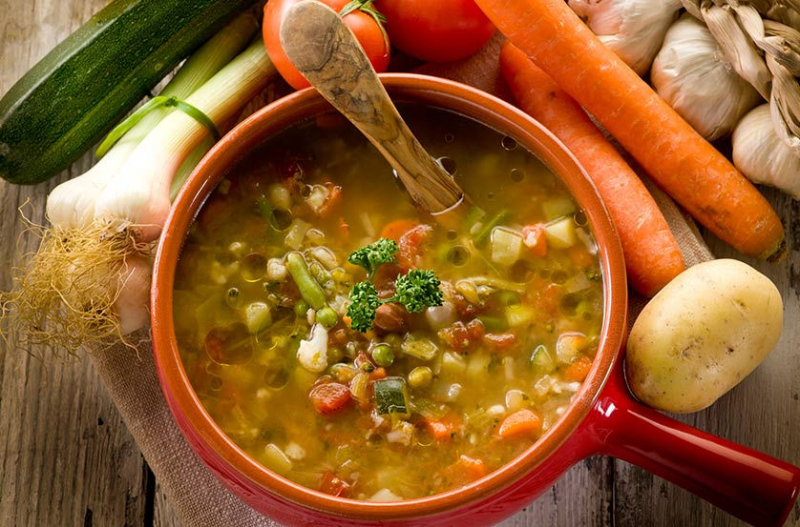
Manestra. Photo: sattvicdevotionaldishes.com 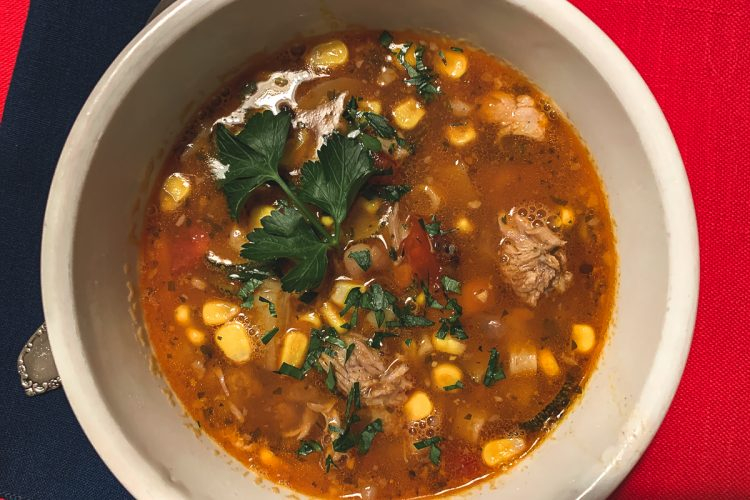
Manestra. Photo: mezzeandtapas.com -
Hvar is a beautiful Adriatic Sea tourist destination and one of Croatia's most inhabited islands. But it is also the birthplace of Gregada, one of Croatia's best delicacies.
Gregada is a white fish stew cooked with potatoes, white wine, garlic, capers, and salted anchovies, as well as a variety of white fish like grouper and scorpionfish (generally whatever has been caught fresh that day). This wonderful cuisine is slow-cooked in a pot for several hours, in keeping with the mellow, laid-back rhythm of life on the Dalmatian islands. The fundamental rule is that it should not be agitated but merely shaken, to avoid breaking up the fish chunks.
Ingredients:
- 1,5 kg of cleaned and scaled fresh white fish
- 500g sliced potatoes
- 300g sliced onions
- 300ml olive oil
- 500ml white wine (dry)
- 300ml water
- 3 to 4 garlic cloves
- Bay leaf, parsley, salt, and pepper
Instructions:
- In a large, shallow, heavy-bottom brazier pot, heat the oil and sauté the onions until they are soft and transparent.
- Sauté for a few minutes more after adding the garlic and potato slices.
- After that, place the fish on top of the potatoes, add a few bay leaves, and cover with just enough water and white wine to cover everything. Gregada should take roughly 20 minutes to prepare.
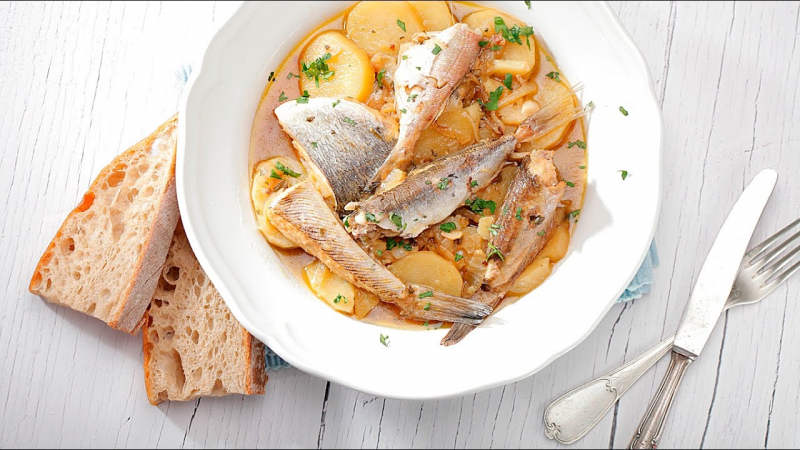
Gregada. Photo: total-croatia-news.com 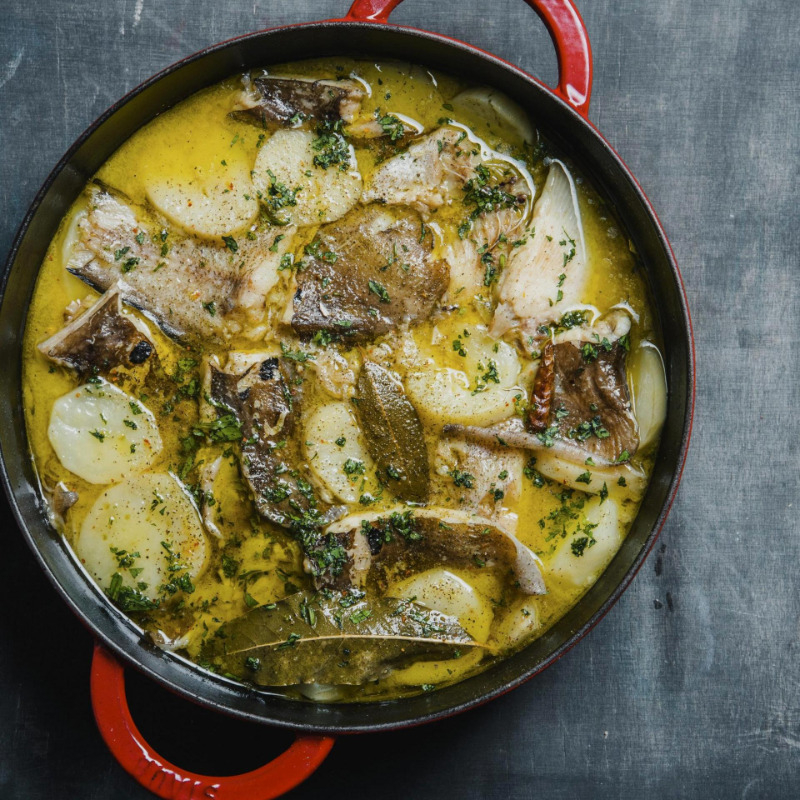
Gregada. Photo: gurman.eu -
Soparnik is from the Poljica region, which is located near Split on the Dalmatian coast. It is a typical flat pizza-like pie stuffed with Swiss chard that's a mainstay of Croatian cuisine.
At the end of July, there is even a festival dedicated to this particular supper, when families compete for the finest Soparnik prize. It's a fantastic opportunity to sample a variety of different types. People from this area are famed for their Swiss chard (also known as "blitva"), and locals are even known as "blitvari" (people who eat Swiss chard).
Ingredients:
- 2.2 pounds of chard
- 2 oz. onion
- 2 garlic cloves
- 4 cups of pastry flour
- Olive oil
- 4 teaspoons oil
- 1,5 cups of water
- 2 tablespoons of parsley, finely chopped
- 1 teaspoon salt
- 1 tablespoon of Vegeta (all-purpose seasoning)
Instructions:
- Heat the oven to 350 degrees Fahrenheit (180 degrees Celsius).
- Make a firm dough with flour, salt, oil, and water.
- Make two balls out of the dough, one larger and one smaller. Allow for 15 minutes of resting time after covering with a cloth.
- Wash and dry the chard thoroughly. It should be cut into small pieces.
- Add the onion to the chard after it has been chopped. Parsley is also a good addition.
- Combine all of the ingredients in a large mixing bowl.
- Take the larger dough piece and roll it out.
- Spread the chard mixture on top of the dough on a baking sheet.
- Take the remaining dough piece and roll it out.
- Place the chard on top of the rolled-out dough.
- Join the upper and lower doughs by pressing the edges of the dough together. To prevent the filling from leaking out, press the sides firmly together.
- Bake the soparnik for 35–40 minutes.
- Chop the garlic and add it to the olive oil while it's baking. Set it aside.
- When the soparnik is done baking, remove it from the oven and coat it with olive oil and garlic while it is still hot.
- Allow cooling somewhat before cutting into triangles or squares.
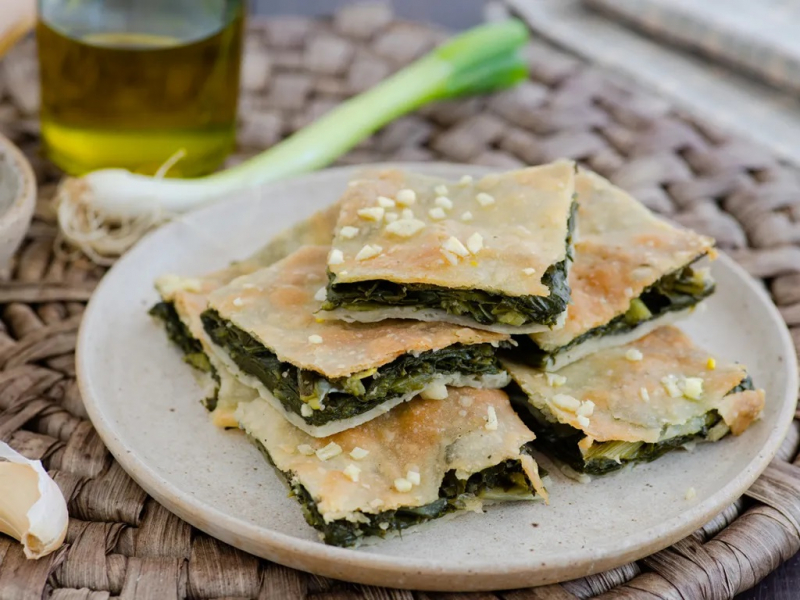
Soparnik. Photo: coolinarika.com 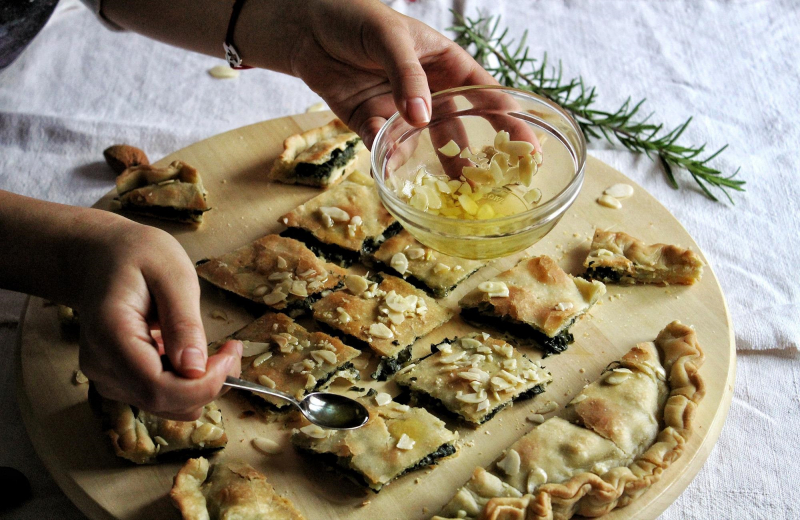
Soparnik. Photo: daviho.com












